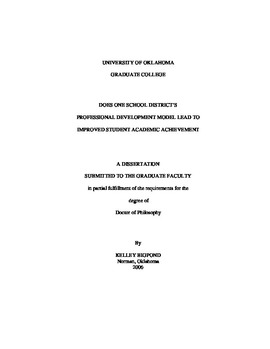| dc.contributor.advisor | Smith, Joan, | en_US |
| dc.contributor.author | Bigpond, Kelley. | en_US |
| dc.date.accessioned | 2013-08-16T12:20:07Z | |
| dc.date.available | 2013-08-16T12:20:07Z | |
| dc.date.issued | 2006 | en_US |
| dc.identifier.uri | https://hdl.handle.net/11244/1024 | |
| dc.description.abstract | The results of this study contribute to narrowing the gap that is documented in the research literature concerning the true impact of professional development at the school district level. In addition, this study attempts to describe those aspects of professional development that may make significant changes in the knowledge, skills, practices, and attitudes of teachers with the ultimate goal of improving student learning. | en_US |
| dc.description.abstract | Educating today's students is dramatically different from educating students decades ago (Healy, 1990). Professional development is often seen as the bridge that empowers teachers to enhance their professional knowledge and practices in order to meet current students' needs. The purpose of this study was to investigate the effects of professional development on classroom teachers at the school district level. Two research questions were addressed: (1) How effective are professional development programs (Differentiation, Tribes Training, and Dr. Lee Jenkins Model) in a suburban/metropolitan school district? (2) What impact do these three professional development programs have on student academic achievement in this school district? | en_US |
| dc.description.abstract | These questions are significant because school districts spend a great deal of money training teachers each year in professional development programs. Due to recent budget cuts, the money might be better spent in other areas if the programs aren't being used in the classroom and if they don't impact student achievement. The study method included coding the qualitative data and using SPSS Statistical Analysis Software to conduct a t-test with three dependent samples (Differentiation vs. Dr. Lee Jenkins Model, Differentiation vs. Tribes Training, and Dr. Lee Jenkins Model vs. Tribes Training) to determine each sample's significance. Data was obtained from 47 classroom teachers. | en_US |
| dc.format.extent | viii, 122 leaves ; | en_US |
| dc.subject | Teachers In-service training Case studies. | en_US |
| dc.subject | Education, Philosophy of. | en_US |
| dc.subject | Education, Teacher Training. | en_US |
| dc.title | Does one school district's professional development model lead to improved student academic achievement? | en_US |
| dc.type | Thesis | en_US |
| dc.thesis.degree | Ph.D. | en_US |
| dc.thesis.degreeDiscipline | Department of Educational Leadership and Policy Studies | en_US |
| dc.note | Source: Dissertation Abstracts International, Volume: 67-03, Section: A, page: 0879. | en_US |
| dc.note | Adviser: Joan Smith. | en_US |
| ou.identifier | (UMI)AAI3211362 | en_US |
| ou.group | Jeannine Rainbolt College of Education::Department of Educational Leadership and Policy Studies | |
